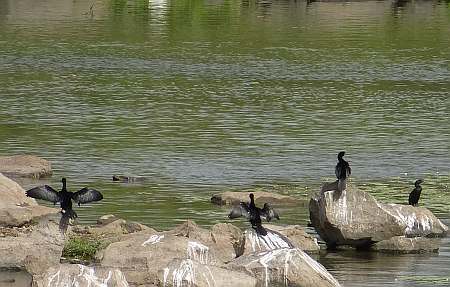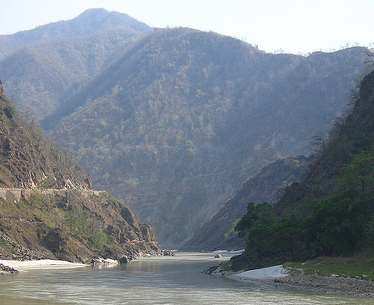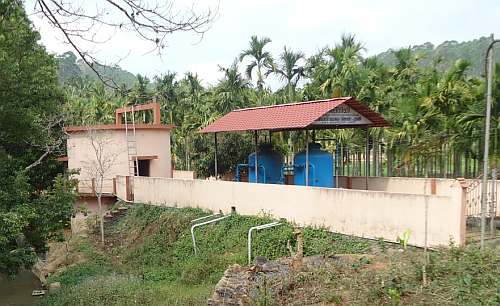On 31st January 2012, the Ministry of Water Resources (MoWR) had released the draft of the National Water Policy 2012 and invited comments till 29 February. Following the meeting of the National Water Board on 7th June 2012, the MoWR has now put up a revised draft on their website. This article presents the salient features of the revised draft and compares it to the previous version.
The revised draft is divided into the following sections:
1. Preamble
This sets the framework for the policy, including the present scenario, concerns, and basic principles of water resource management. This mentions the interdependence of all elements of the hydrological cycle, and of the need for equity.

Adequate environmental flows are necessary for aquatic and terrestrial life (Image courtesy: Chicu Lokgariwar)
The two drafts differ from each other only on one crucial point. The term 'ecological needs' has been preceded by 'minimum' in the second draft. Considering that ecosystems depend on a range of flows that together form the flow regime of a river, and looking at the criminal inadequacy of 'minimum discharge' as practiced today, this regression from ecological flows to 'minimum ecological need' is extremely disturbing.
2. Water framework law
The 'overarching water framework law' mentioned in the first draft is elaborated upon here. It is defined as 'an umbrella statement of general principles governing the exercise of legislative and/or executive (or devolved) powers by the Centre, the States and the local governing bodies'. The framework law emphasises the need to manage water under public trust doctrine and recommends the modification of existing acts that give proprietary rights over groundwater.
3. Uses of water
The first draft's recommendation to consider water as an economic good after setting aside a 'minimum quantity' for drinking water and ecological needs has been removed in this version.
4. Adaptation to climate change
This section mentions variability in water resources, the need to experiment with cropping patterns, and describes dams and flood embankments as coping strategies. The revised version differs from the earlier in its recognising demand management as a viable adaptation strategy.
5. Enhancing water available for use
This section lays heavy stress on large centralized engineering both while estimating water availability and while determining a strategy for future use. Inter-basin transfers are considered necessary in both the drafts. However, the revised version mentions the use of 'integrated watershed development activities with groundwater perspectives' for increasing land and water productivity. This is a healthy step towards integrating the conservation of ground and surface water.

Groundwater , accessed through springs, is critical for the survival of mountain communities (Image courtesy: Raju Mimi)
6. Demand management and water use efficiency
Water audit, institutional arrangements for demand management, reuse and recycle are considered. The revised version does not deviate significantly from the first draft. However, it does emphasise to a greater degree the importance of water audits and water footprints.
7. Water pricing
The revised version maintains the original premise that beyond basic needs, water is to be treated an an economic good and priced accordingly. Differential pricing for basic needs, volumetric pricing, incentives for recycling water and the establishment of a state water regulatory authority are the measures suggested in the second draft.
8. Conservation of river corridors, water bodies and infrastructure
'River corridors' and other water bodies are threatened by over-exploitation, pollution, and infrastructure development. This section talks of the need for their conservation. The revised version is true to the spirit of the first draft, but refines a few points touched upon earlier. These include protection of aquifer recharge areas and reservoir catchments, and maintenance of urban water bodies.
9. Project planning and implementation
This concerns itself with the speedy execution of projects through concurrent monitoring by the State and the Centre. The revised draft appears to dismiss responsible stewardship of the environment by incorporating two significant changes. It recommends that environmental clearance be made time bound to reduce 'economic loss due to delay in implementation of projects'. This will cause environmental clearance to mean superficial adherence to the letter of the law rather than a honest and unbiased evaluation of environmental impacts.
Similarly, it recommends that hydropower projects should be planned with provision of storage. This ignores the several studies and testimonies that prove that storage-based hydroelectricity projects are catastrophic to earthquake-vulnerable and biodiversity-rich areas like the Himalayas.

Beautiful but fragile: Himalayan river valleys are prone to landslides and located in earthquake prone areas (Image courtesy: Chicu Lokgariwar)
10A. Resettlement and rehabilitation (Deleted)
The earlier draft had a short section on this important topic. While this section lacked details, its presence implied that the issue was being taken cognizance of. The chapter has been deleted in the revised version. This seems to indicate that the MoWR does not consider the resettlement and rehabilitation of people displaced by water projects to be its responsibility.
10. Management of flood and drought
Earlier titled 'Preparedness for flood and drought', its focus was on developing structural controls for floods and on developing disaster management plans. This technocentric approach holds good. Both versions also acknowledge that protection is not fool-proof and so encourage the need for developing coping strategies and mechanisms.

Rains lash a flooded landscape during the 2007 Bihar floods (Image courtesy: Megh Pyne Abhiyaan)
11. Water supply and sanitation
Reducing the disparity between urban and rural water supply, encouraging water metering and water audits are mentioned in both the drafts. The revised version recommends offering incentives for decentralised and water-saving sanitation and sewerage systems. It also recommends rainwater harvesting and desalination rather than the latter alone, as a means of increasing water availability in urban and industrial areas.
12. Institutional arrangements
Mechanisms to resolve water disuptes within the states and at the national level are recommended. The earlier explicit recommendation that the State confine itself to regulation of services, while provision is to be done by the community or private sector has been modified. Instead, there is a suggestion that the State can now decide to encourage the private sector to become a service provider. This results in the role of service provider being g denied to the community.

The Nenmeni Rural Water Supply System is a successful example of successful service provision by the community (image courtesy: PK Kurian, Kurian Baby, and Terry Thomas)
13. Transboundary rivers
Earlier titled 'international rivers', this section stresses developing bilateral agreements while maintaining national interests.
14. Database and information system
A separate authority is recommended to manage data related to water, other than data that has to be kept secret due to national security reasons. An important revision in the new draft is the recommendation of a periodic review for declassification of data. It also recommends a programme of intensive data collection for studying climate change.
15. Research and training needs
There are no significant differences between the two drafts.
16. Implementation of the National water policy
This section, new to this draft, recommends that the National Water Board create and monitor the implementation of a plan of action based on the water policy.
Comments from the public on the first draft
A summary and discussion of the first draft is available on the India Water Portal here. The following is a summary of the responses received from readers, on the first draft:
- Several readers expressed concern over the relatively short time allowed for receiving comments. A 90-day notice, adequate representation of BPL households and SC/ST people in the stakeholder meetings, advertisements informing people of the draft were recommended measures to ensure participation in true spirit.
- A reduction in water withdrawal through demand management, increased water use efficiency, recycling and reuse was emphasised as necessary, and ways of achieving this goal were outlined.
- The use of alternative technologies and decentralised projects for water harvesting and flood mitigation were suggested. At the same time, users recommended the establishment of an administrative system on geographical principles for coordination, operation and control of our water resources.
- The first draft's leanings towards privatization of water hit a nerve, with several users emphasizing that water is a natural resource and not a commodity.
Do you think the revised draft has incorporated comments from the public ?
References
- Revised draft of the National water policy 2012 (English), released by the Ministry of Water Resources (MoWR), in June 2012
- Revised draft of the National water policy 2012 (Hindi), released by the Ministry of Water Resources (MoWR), in June 2012
- First draft of the National Water Policy 2012, released by the Ministry of Water Resources (MoWR), in January 2012